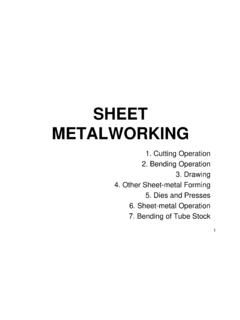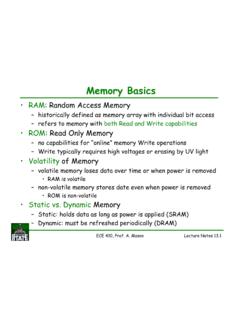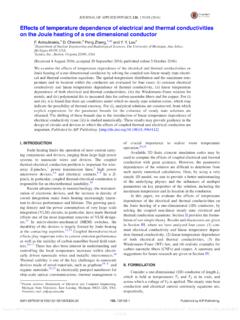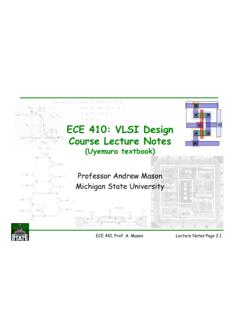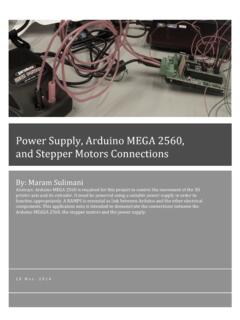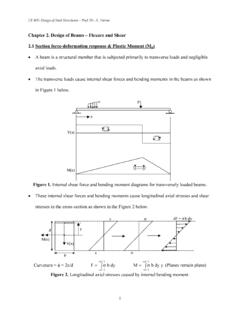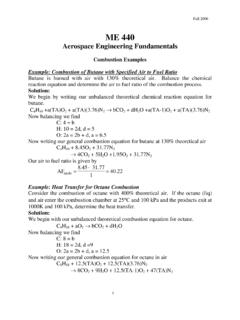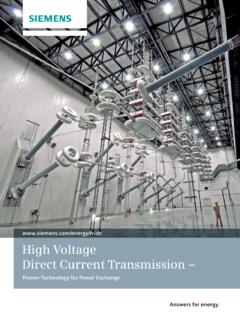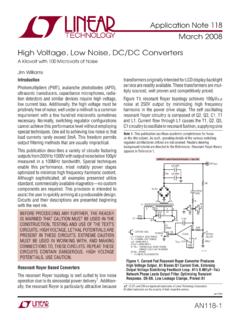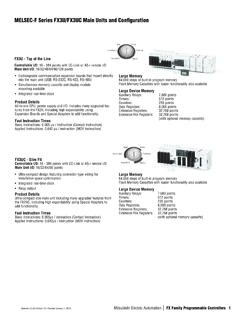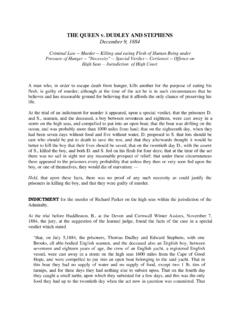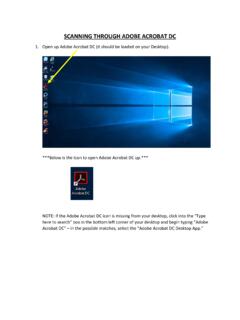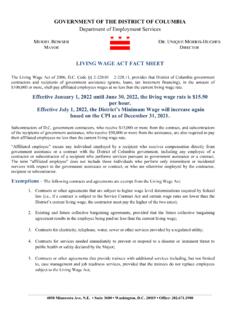Transcription of CMOS Inverter: DC Analysis - Michigan State University
1 ECE 410, Prof. A. MasonLecture Notes Inverter: DC Analysis Analyze DC Characteristics of CMOS Gates by studying an Inverter DC Analysis DC value of a signal in static conditions DC Analysis of CMOS Inverter Vin, input voltage Vout, output voltage single power supply, VDD Ground reference find Vout = f(Vin) Voltage Transfer Characteristic (VTC) plot of Vout as a function of Vin vary Vin from 0 to VDD find Vout at each value of VinECE 410, Prof. A. MasonLecture Notes Voltage Transfer Characteristics Output High Voltage, VOH maximum output voltage occurs when input is low (Vin = 0V) pMOS is ON, nMOS is OFF pMOS pulls Vout to VDD VOH= VDD Output Low Voltage, VOL minimum output voltage occurs when input is high (Vin = VDD) pMOS is OFF, nMOS is ON nMOS pulls Vout to Ground VOL= 0 V Logic Swing Max swing of output signal VL= VOH-VOL VL= VDDECE 410, Prof. A. MasonLecture Notes Voltage Transfer Characteristics Gate Voltage, f(Vin) VGSn=Vin, VSGp=VDD-Vin Transition Region (between VOHand VOL) Vinlow Vin< Vtn Mnin Cutoff, OFF Mp in Triode, Vout pulled to VDD Vin> Vtn< ~Vout Mn in Saturation, strong current Mp in Triode, VSG& current reducing Vout decreases via current through Mn Vin = Vout (mid point) VDD Mn and Mp both in Saturation maximum current at Vin = Vout Vinhigh Vin > ~Vout, Vin < VDD - |Vtp| Mn in Triode, Mp in Saturation Vin > VDD - |Vtp| Mnin Triode, Mp in Cutoff+VGSn-+VSGp-Vin < VILinput logic LOWVin > VIHinput logic HIGH Drain Voltage, f(Vout) VDSn=Vout, VSDp=VDD-VoutECE 410, Prof.
2 A. MasonLecture Notes Margin Input Low Voltage, VIL Vin such that Vin < VIL= logic 0 point a on the plot where slope, Input High Voltage, VIH Vin such that Vin > VIH= logic 1 point b on the plot where slope =-1 Voltage Noise Margins measure of how stable inputs are with respect to signal interference VNMH= VOH-VIH= VDD - VIH VNML= VIL-VOL= VIL desire large VNMHand VNMLfor best noise immunity1 = VoutVinECE 410, Prof. A. MasonLecture Notes Threshold Switching threshold = point on VTC where Vout = Vin also called midpoint voltage, VM here, Vin = Vout = VM Calculating VM at VM, both nMOS and pMOS in Saturation in an inverter, IDn= IDp, always! solve equation for VM express in terms of VM solve for VMDptpSGpptnGSnntnGSnOXnDnIVVVVVVLWCI= = = =222)(2)(2)(2 22)(2)(2tpMDDptnMnVVVVV = tpMDDtnMpnVVVVV = )( pnpntntpMVVVDDV ++ =1 ECE 410, Prof. A. MasonLecture Notes of Transistor Size on VTC Recall If nMOS and pMOS are same size (W/L)n = (W/L)p Coxn= Coxp(always) If Effect on switching threshold if n pand Vtn = |Vtp|, VM= VDD/2, exactly in the middle Effect on noise margin if n p, VIHand VILboth close to VMand noise margin is goodLWknn'= ppnnpnLWkLWk ='' pnpntntpMVVVDDV ++ =132orLWCLWC pnpoxppnoxnnpn = = 1,= =pnnppnthenLWLW since L normally min.
3 Size for all tx,can get betas equal by making Wp larger than WnECE 410, Prof. A. MasonLecture Notes Given k n = 140uA/V2, Vtn = , VDD = 3V k p = 60uA/V2, Vtp = Find a) tx size ratio so that VM= b) VMif tx are same sizetransition pushed loweras beta ratio increasesECE 410, Prof. A. MasonLecture Notes Inverter: Transient Analysis Analyze Transient Characteristics of CMOS Gates by studying an Inverter Transient Analysis signal value as a function of time Transient Analysis of CMOS Inverter Vin(t), input voltage, function of time Vout(t), output voltage, function of time VDD and Ground, DC (not function of time) find Vout(t) = f(Vin(t)) Transient Parameters output signal rise and fall time propagation delayECE 410, Prof. A. MasonLecture Notes Response Response to step change in input delays in output due to parasitic R & C Inverter RC Model Resistances Rn= 1/[ n(VDD-Vtn)] Rp= 1/[ n(VDD-|Vtp|)] Output Cap.
4 (only output is important) CDn(nMOS drain capacitance) CDn= Cox WnL + CjADnbot+ CjswPDnsw CDp(pMOS drain capacitance) CDp= Cox WpL + CjADpbot+ CjswPDpsw Load capacitance, due to gates attached at the output CL= 3 Cin = 3 (CGn+ CGp), 3 is a typical load Total Output Capacitance Cout= CDn+ CDp+ CL+Vout-CLterm fan-out describes# gates attached at outputECE 410, Prof. A. MasonLecture Notes Time Fall Time, tf time for output to fallfrom 1 to 0 derivation: initial condition, Vout(0) = VDD solution definition tfis time to fall from90% value [V1,tx]to 10% value [V0,ty] tf= nnoutoutoutRVtVCi= =ntDDeVtVout =)( n= RnCouttime constant =VoutVtDDnln = ECE 410, Prof. A. MasonLecture Notes Time Rise Time, tr time for output to rise from 0 to 1 derivation: initial condition, Vout(0) = 0V solution definition tfis time to rise from10% value [V0,tu]to 90% value [V1,tv] tr= p Maximum Signal Frequency fmax= 1/(tr+ tf) faster than this and the output can t settle p= RpCouttime constantpoutDDoutoutRVVtVCi = = = ptDDeVtVout 1)(ECE 410, Prof.
5 A. MasonLecture Notes Delay Propagation Delay, tp measures speed of output reaction to input change tp= (tpf+ tpr) Fall propagation delay, tpf time for output to fall by 50% reference to input change by 50% Rise propagation delay, tpr time for output to rise by 50% reference to input change by 50% Ideal expression (if input is step change) tpf= ln(2) n tpr= ln(2) p Total Propagation Delay tp= ( n + p)Propagation delay measurement:- from time input reaches 50% value- to time output reaches 50% valueAdd rise and fall propagation delays for total valueECE 410, Prof. A. MasonLecture Notes Speed -Resistance Rise & Fall Time tf= n, tr= p, Propagation Delay tp= ( n + p) In General delay n + p n + p= Cout (Rn+Rp) Define delay in terms of design parameters Rn+Rp= (VDD-Vt)( n+ p) Rn+Rp= n + p if Vt = Vtn = |Vtp| n= RnCout p= RpCoutRn = 1/[ n(VDD-Vtn)]Rp = 1/[ p(VDD-|Vtp|)]Cout = CDn+ CDp+ CL = Cox (W/L) n p(VDD-Vt)2 n p(VDD-Vt)Rn+Rp = 2 = 2 L (VDD-Vt)Rn+Rp = L ( n+ p) Cox W(VDD-Vt)( n p) Cox W (VDD-Vt)and L=Ln=LpBeta Matchedif n= p= ,Width Matchedif Wn=Wp=W,To decrease R s, L, W, VDD, ( p, Cox )ECE 410, Prof.
6 A. MasonLecture Notes Speed -Capacitance From Resistance we have L, W, VDD, ( p, Cox ) but VDD increases power W increases Cout Cout Cout = Cox L (Wn+Wp) + Cj2L (Wn+Wp) + 3 Cox L (Wn+Wp) assuming junction area ~W 2L neglecting sidewall capacitance Cout L (Wn+Wp) [3 Cox +2 Cj] Cout L (Wn+Wp) Delay Cout(Rn+Rp) L W LCout = CDn+ CDp+ CLCL= 3 (CGn+ CGp) = 3 Cox (WnL+WpL)CDp= Cox WpL + CjADpbot+ CjswPDpswCDn= Cox WnL + CjADnbot+ CjswPDnswestimateif L=Ln=LpW~2 LLTo decrease Cout, L, W, ( Cj, Cox )W VDD= L2 VDDD ecreasing L (reducing feature size)is best way to improve speed!ECE 410, Prof. A. MasonLecture Notes Speed -Local Modification Previous Analysis applies to the overall design shows that reducing feature size is critical for higher speed general result useful for creating cell libraries How do you improve speed within a specific gate? increasing W in one gate will not increase CGof the load gates Cout = CDn+ CDp+ CL increasing W in one logic gate will increase CDn/pbut not CL CLdepends on the size of the tx gates at the output as long as they keep minimum W, CLwill be constant thus, increasing W is a good way to improve the speed within a local point But, increasing W increases chip area needed, which is bad fast circuits need more chip area (chip real estate ) Increasing VDD is not a good choice because it increasespower consumptionECE 410, Prof.
7 A. MasonLecture Notes Power Consumption P = PDC+ Pdyn PDC: DC (static) term Pdyn: dynamic (signal changing) term PDC P = IDDVDDDD IDDDC current from power supply ideally, IDD= 0 in CMOS: ideally only current during switching action leakage currents cause IDD> 0, define quiescentleakage current, IDDQ(due largely to leakage at substrate junctions) PDC= IDDQVDD Pdyn, power required to switch the State of a gate charge transferred during transition, Qe = Cout VDD assume each gate must transfer this charge 1x/clock cycle Paverage= VDDQe f = Cout VDD2f, f = frequency of signal change Total Power, P = IDDQVDD+ Cout VDD2fPower increases with Cout and frequency, and stronglywith VDD (second order).ECE 410, Prof. A. MasonLecture Notes Gate Signal Transitions In multi-input gates multiple signal transitions produce output changes What signal transitions need to be analyzed? for a general N-input gate with M0low output states and M1high output states # high-to-low output transitions = M0 M1 # low-to-high output transitions = M1 M0 total transitions to be characterized = 2 M0 M1 example: NAND has M0= 1, M1= 3 don t test/characterize cases without output transitions Worst-case delayis the slowest of all possible cases worst-case high-to-low worst-case low-to-high often different input transitions for each of these casesECE 410, Prof.
8 A. MasonLecture Notes Equivalent Circuits Scale both W and L no effective change in W/L increases gate capacitance Series Transistors increases effective L Parallel Transistors increases effective Weffective effective 2 = Cox (W/L)inputs must be at same value/voltageECE 410, Prof. A. MasonLecture Notes : DC Analysis Multiple Inputs Multiple Transitions Multiple VTCs VTC varies with transition transition from 0,0 to 1,1pushed right of others why? VMvaries with transition assume all txhave same L VM= VA= VB= Vout can merge transistors at this point if WpA=WpBand WnA=WnB series nMOS, N n parallel pMOS, P 2 p can now calculate the NAND VMECE 410, Prof. A. MasonLecture Notes Switching Point Calculate VM for NAND 0,0 to 1,1 transition all tx change states (on, off) in other transitions, only 2 change VM= VA= VB= Vout set IDn= IDp, solve for VM denominator reduced more VTC shifts right For NAND with N inputspnpntntpMVVVDDV 21121++ =pnpntntpMNNVVVDDV 111++ =series nMOS means more resistance to output falling, shifts VTC to rightto balance this effect and set VMto VDD/2, can increase by increasing Wnbut, since n> p, VM VDD/2 when Wn = WpECE 410, Prof.
9 A. MasonLecture Notes : DC Analysis Similar Analysis to NAND Critical Transition 0,0 to 1,1 when all transistors change VMfor NOR2 critical transition if WpA=WpBand WnA=WnB parallel nMOS, n 2 n series pMOS, p p series pMOS resistance means slower rise VTC shifted to the left to set VMto VDD/2, increase Wp this will increase ppnpntntpMVVVDDV 212++ =pnpntntpMNNVVVDDV ++ =1for NOR2for NOR-NECE 410, Prof. A. MasonLecture Notes : Transient Analysis NAND RC Circuit R: standard channel resistance C: Cout = CL+ CDn+ 2 CDp Rise Time, tr Worst case charge circuit 1 pMOS ON tr= p p= RpCout best case charge circuit 2 pMOS ON, Rp Rp/2 Fall Time, tf Discharge Circuit 2 series nMOS, Rn 2Rn must account for internal cap, Cx tf= n n= Cout (2 Rn) + Cx RnCx = CSn+ CDnECE 410, Prof. A. MasonLecture Notes : Transient Analysis NOR RC Circuit R: standard channel resistance C: Cout = CL+ 2 CDn+ CDp Fall Time, tf Worst case discharge circuit 1 nMOS ON tf= n n= RnCout best case discharge circuit 2 nMOS ON, Rn Rn/2 Rise Time, tr Charge Circuit 2 series pMOS, Rp 2Rp must account for internal cap, Cy tr= p p= Cout (2 Rp) + Cy RpCy = CSp+ CDpECE 410, Prof.
10 A. MasonLecture Notes Performance Inverter: symmetry (VM=VDD/2), n = p (W/L)p= n/ p(W/L)n Match INV performance with NAND pMOS, P= p, same as inverter nMOS, N= 2 n, to balance for 2 series nMOS Match INV performance with NOR pMOS, P= 2 p, to balance for 2 series pMOS nMOS, N= n, same as inverter NAND and NOR will stillbe slower due to larger Cout This can be extended to3, 4, .. N input NAND/NORgates is adjusted by changing transistor size (width)ECE 410, Prof. A. MasonLecture Notes Transient Summary Critical Delay Path paths through series transistors will be slower more series transistors means worse delays Tx Sizing Considerations increase W in series transistors balance n/ pfor each cell Worst Case Transition when all series transistor go from OFF to ON and all internal caps have to be charged (NOR) discharged (NAND)ECE 410, Prof. A. MasonLecture Notes Considerations Speed based on n, p and parasitic caps DC performance (VM, noise) based on n/ p Design for speed not necessarily provide good DC performance Generally set tx size to optimize speedand then test DC characteristics to ensure adequate noise immunity Review Inverter: Our performance reference point for symmetry (VM=VDD/2), n = p which requires (W/L)p= n/ p(W/L)n Use inverter as reference point for more complex gates Apply slowest arriving inputs to series node closest to output let faster signals begin to charge/discharge nodes closer to VDD and Groundfastersignaloutputpower supplyslowersignalECE 410, Prof.
